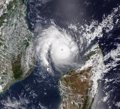A new study from the UN Department of Economic and Social Affairs predicts a 2.3% increase in the world economy this year but warns that the prospects for world economic recovery remain bleak in a context of persistent, rising inflation of interest rates and greater uncertainties.
The global economy faces the risk of a long period of low growth, as the lingering effects of the COVID-19 pandemic, the growing impact of climate change and macroeconomic structural challenges remain unresolved, according to the latest update of the World Economic Situation and Prospects report.
The study forecasts that the world economy will grow by 2.3% in 2023 (0.4% compared to the January forecast) and 2.5% in 2024 (-0.2 percentage points), which represents a slight rebound in global growth forecast for 2023.
The recovery in household spending has led to an upward revision of the growth forecast in the United States, to 1.1% in 2023.
The economy of the European Union, driven by the drop in gas prices and strong consumer spending, will grow by 0.9%. China’s growth this year is now forecast at 5.3% as a result of the lifting of COVID-19-related restrictions.
Despite progress, the outlook remains bleak
Despite this rebound in the main economies, the growth rate is still well below the 3.1% average recorded in the two decades prior to the pandemic.
For many developing countries, growth prospects have deteriorated due to tightening credit conditions and rising costs of external financing.
Forecasts indicate that in Africa and Latin America and the Caribbean GDP per capita will increase only marginally this year, reinforcing a long-term trend of stagnant economic performance.
The least developed countries are expected to grow by 4.1% in 2023 and 5.2% in 2024, well below the established 7% growth target in the 2030 Agenda of Sustainable Development.
A challenge for the Development Goals
A situation that represents “an immediate challenge for the fulfillment of the Sustainable Development Goals”, in the words of Li Junhua, UN Assistant Secretary General for Economic and Social Affairs.
“The international community must urgently address the growing shortage of finance faced by many developing countriesstrengthening their capacities to make critical investments in sustainable development and helping them transform their economies to achieve inclusive and sustained long-term growth,” he advised.
He also recalled that world trade continues to be under pressure due to geopolitical tensions, the weakening of world demand and the tightening of monetary and fiscal policies.
It is anticipated that the volume of world trade in goods and services grows 2.3% in 2023, well below the pre-pandemic trend.
Inflation remains high in many countries
World average inflation is expected to stand at 5.2% in 2023, compared to the maximum reached for two decades in 2022 (7.5%).
Although upward price pressures are expected to ease slowly, In many countries, inflation will remain well above central bank targets.
Amid local supply disruptions, high import costs and market imperfections, food inflation remains high in most developing countries, which disproportionately affects the poor, especially women and children.
The strength of labor markets in developed economies is a positive point. For example, in the United States, Europe and other developed economies, employment rates continue to resist, a trend that favored solid household spending.
Against this backdrop of widespread worker shortages and low unemployment rates, wages have risen. Employment rates have reached record levels in many developed economies and the differences between men and women have narrowed since the pandemic.
Greater political cooperation
The extraordinary strength of labor markets makes it difficult for central banks to control inflation.
The Federal Reserve, the European Central Bank and the central banks of other developed countries continued to raise interest rates in 2023, but at a slower pace than last year, which saw the most aggressive monetary tightening in decades.
In turn, the disturbances in the banking sector in the United States and Europe added new uncertainties and challenges to monetary policies.
While swift action by regulators helped contain risks to financial stability, it is likely that vulnerabilities in the global financial architecture and the measures taken to contain them hold back credit and investment growth in the future.
The rapid adjustment in global financial conditions poses significant risks for many developing countries and economies in transition. Today’s political challenges call for greater cross-border political cooperation and concerted global action to prevent many developing economies from becoming trapped in a vicious cycle of low growth and high debt.




![[Img #74661]](https://thelatestnews.world/wp-content/uploads/2024/12/The-power-of-ultrasound-150x150.jpg)









